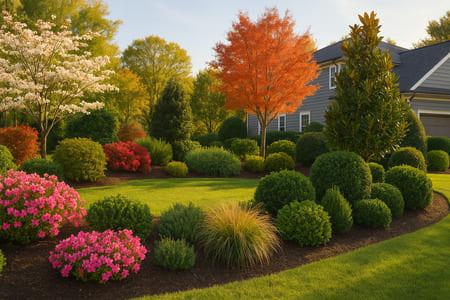
Seasonal Landscaping Guide: What to Plant Each Season in North Georgia

Want reliable color and curb appeal that lasts? Here's a simple, local guide to seasonal planting that works with our North Georgia climate. If you're planning updates in Sandy Springs, GA, the easiest path is to pair the right plant with the right season and let the weather do the heavy lifting. For a smooth start, explore our landscaping services from Four Boots Landscape & Construction and get a design that's timed to thrive.
Why Seasonal Landscaping Matters in Sandy Springs, GA
Sandy Springs sits in the North Atlanta area, where winters are cool, springs are quick, and summers run hot and humid. Most yards fall around USDA Zones 7b to 8a, which favors spring blooms, summer perennials, and fall shrub and tree planting. Neighborhoods like Riverside and Huntcliff along the Chattahoochee can be slightly cooler and hold more moisture, while areas near Perimeter Center and High Point often run warmer and drier. Matching plants to these micro-differences keeps maintenance low and results high.
Spring Planting: Color And Fresh Growth
Trees and Shrubs That Pop
Spring is showtime for flowering trees and evergreen structure. Dogwood, redbud, and serviceberry bring early color. For evergreen backbone, consider southern magnolia cultivars, tea olive for fragrance, and compact hollies for year-round form. Azaleas and camellias love our acidic soils and filtered shade, especially under tall pines common across Sandy Springs.
Perennials That Love Spring Starts
Perennials like coneflower, black-eyed Susan, and coreopsis settle in well with mild spring temperatures. Liriope, mondo grass, and ferns fill shady corners near tree canopies in neighborhoods such as North Springs and the Chastain Park edges. Add oakleaf hydrangea for big seasonal interest and fall foliage color.
- Great spring starters: dogwood, redbud, azalea, oakleaf hydrangea, coneflower, coreopsis
- Shade-friendly picks: camellia, tea olive, fern, hellebore, liriope, mondo grass
Spring storms can be intense. Keep new plants protected from wind pockets and afternoon scorch in open, south-facing spots. A steady, moderate watering plan helps roots establish during our rollercoaster spring weather.
Summer Planting: Heat-Wise Choices
Mid-summer installs are possible, but they demand heat-tolerant plants and careful timing. Go for plants that take sun and handle brief dry spells once established. Think ornamental grasses, tough perennials, and resilient shrubs that won't blink at a Sandy Springs heat wave.
Try switchgrass, muhly grass, little bluestem, and rosemary for structure and texture. For flower power, lantana, salvia, and daylily bring color without fuss. Where afternoon shade exists, hardy gardenias and abelias offer bloom and fragrance with a refined look.
In low-lying river-adjacent pockets, choose deep-rooted shrubs and perennials that don't mind occasional soggy spells. On hot slopes near driveways and stone walls, use sun lovers like yucca and juniper to hold grade and keep a tidy, architectural look.
Fall Planting: The Prime Season In North Georgia
Fall is the best season to plant in North Georgia. Cooler air and warm soil let roots run before winter, which supports a stronger flush next spring. Trees and shrubs installed now often outperform spring installs by the following year.
Best Fall Trees and Shrubs
Plant shade and ornamental trees in fall for a confident start: elm and maple cultivars for canopy, crape myrtle for summer bloom, and yaupon holly or inkberry holly for evergreen structure. For native beauty, add American beautyberry with purple berries that birds love.
Perennials and Groundcovers
Fall is perfect for perennials like aster, goldenrod, and heuchera. They focus energy underground, then leap forward when the weather warms. Groundcovers such as ajuga and pachysandra knit together bare areas along foundation beds before winter sets in.
- Plant in fall for stronger roots and easier establishment
- Great fall installs: crape myrtle, yaupon holly, inkberry, aster, goldenrod, heuchera
Use pine straw or hardwood mulch to buffer temperature swings and suppress weeds. Keep mulch away from trunks and stems to prevent rot. A clean, even layer also frames the bed lines and sharpens the curb appeal.
Winter Interest: Evergreen, Structure, And Quiet Color
Winter is when structure shines. Camellia sasanqua can bloom into early winter, while hellebores flower when little else does. Evergreen shrubs like boxwood and holly give form, and red-twig dogwood or winterberry add color and wildlife value. Ornamental grasses left standing offer texture through frost and look great against morning light.
Containers by the front entry can carry the season with dwarf conifers, pansies, and violas. If you're on a shady street lined with old oaks, try glossy anise or mahonia for a deep green backdrop. Thoughtful winter choices keep your property looking finished even on gray days.
Native And Low-Maintenance Plants That Thrive
Native and region-adapted plants tend to be easier to keep happy in Sandy Springs soils. They suit our rainfall patterns and handle the summer heat. Oakleaf hydrangea, itea, fothergilla, little bluestem, and switchgrass are excellent starting points. For pollinators, mix in bee balm, mountain mint, and coneflower to support butterflies and bees across the warm months.
Deer browse varies by street, but deer-resistant options like rosemary, boxwood, beautyberry, abelia, and ornamental grasses hold up well in many neighborhoods. Choose a mix of evergreen, flowering, and textural plants so your beds still look full even when one group is out of season.
Match Plants To Microclimates In Sandy Springs
Our city's terrain shifts from river flats to upland hills, so small siting choices matter. Riverside and Huntcliff can be cooler and hold morning fog. Perimeter-area heat islands can stress spring bloomers that dislike hot roots. Shaded lanes near Chastain Park reward shade-lovers that keep their color under tall canopies.
Focus on three simple filters: sun, soil, and slope. Full-sun perennials belong in south or west exposures. Shade plants like hellebores shine under pines and oaks. On slopes, deep-rooted shrubs and grasses help secure soil. In wetter pockets, inkberry holly and river-friendly natives tolerate brief saturation. When in doubt, choose the right plant for the right place to avoid extra maintenance later.
For broader planning ideas and to see how a four-season layout comes together, skim examples of landscaping in Sandy Springs, GA and notice how designers layer evergreens with seasonal color. This keeps the yard alive month after month instead of peaking once and fading.
Year-Round Planting Snapshot For North Georgia
Use this quick view to map your year. It's not a strict calendar, since weather shifts, but it gives homeowners in Sandy Springs a reliable rhythm.
Spring: Install flowering trees and shrubs, refresh perennials, and set groundcovers in shaded beds. Avoid crowding new installs right before a warm front.
Summer: Plant heat-ready perennials and grasses where needed. Group tough shrubs in sunny problem spots and keep new installs watered consistently after sundown.
Fall: This is the sweet spot for trees, shrubs, and many perennials. Plant in fall for stronger roots so spring growth is fuller and more colorful.
Winter: Lean on evergreen structure, hellebores, and berries for color. Prune only as appropriate for the plant and season, and keep beds neat with a clean mulch line.
Design Tips That Pay Off In Every Season
Create a backbone first, then layer color. Evergreen shrubs like holly, tea olive, and compact magnolia set the frame. Add flowering shrubs that bloom at different times so you always have something happening. Finish with perennials and grasses for movement and long color windows. A two- to three-inch mulch layer protects roots and keeps weeds down; mulch 2–3 inches to protect roots without piling against trunks.
Favor low-water, disease-resistant varieties to keep maintenance predictable. In deer-prone areas, cluster deer-resistant plants at edges and along paths to reduce browse pressure. In HOA settings, tidy forms like boxwood, dwarf yaupon, and abelia deliver a polished look that still feels soft and welcoming.
Finally, watch for invasive plants and remove them when discovered. English ivy and certain nandina types can spread beyond beds. Avoid invasive species and lean on natives or well-behaved cultivars that support pollinators and local birds.
Bring Your Yard To Life With Local Expertise
Ready to build a plan that fits your lot, your light, and your schedule? Four Boots Landscape & Construction designs, installs, and maintains four-season plantings all over Sandy Springs, GA. If you want a clear, professional layout and a crew that shows up ready, talk with us about full-service landscaping that's timed to succeed.
Call 470-233-2099 to schedule your on-site assessment. We'll match plants to your microclimates and create a year-round look you'll be proud of.
Get On The Greener Side With Our Landscaping Services In Dunwoody Area!